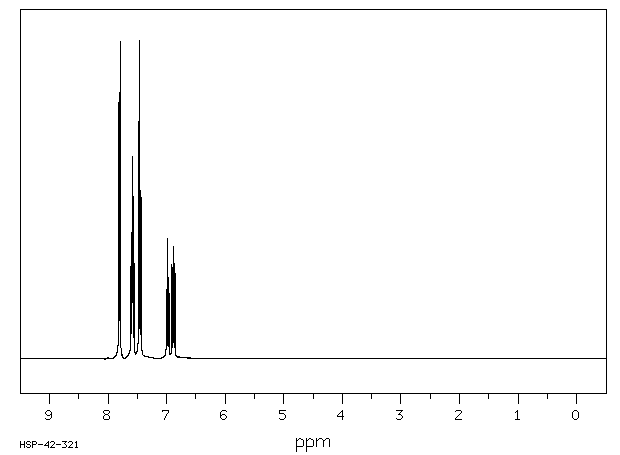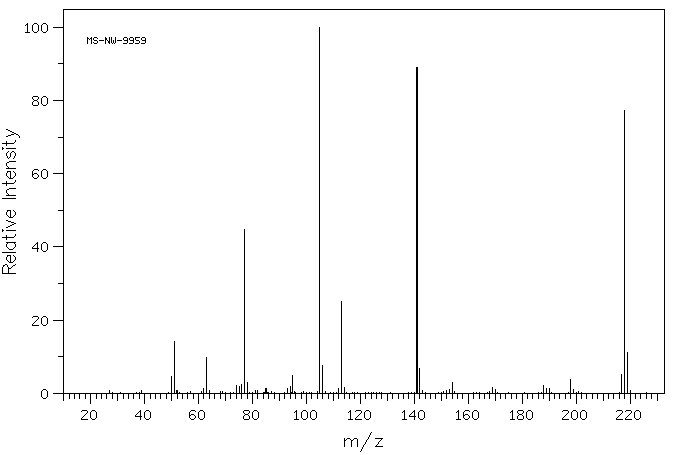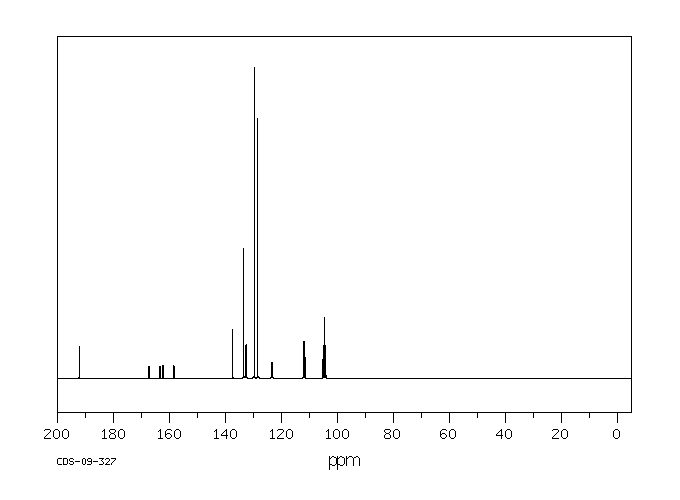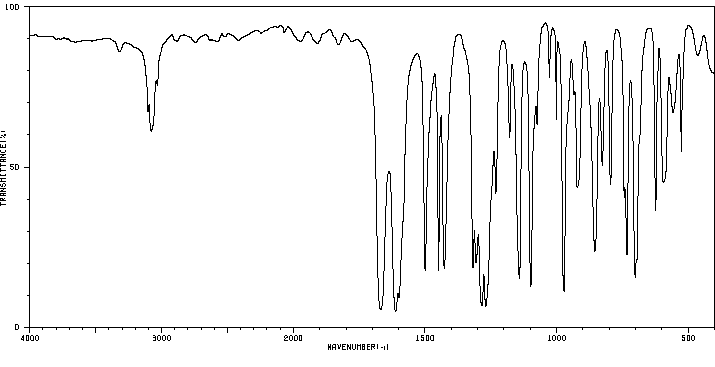2,4-二氟二苯甲酮 | 85068-35-5
中文名称
2,4-二氟二苯甲酮
中文别名
2,4-二氟苯甲酮
英文名称
(2,4-difluorophenyl)(phenyl)methanone
英文别名
2,4-difluorobenzophenone;(2,4-difluorophenyl)-phenylmethanone
CAS
85068-35-5
化学式
C13H8F2O
mdl
——
分子量
218.203
InChiKey
FRHMSTHFVFIPCO-UHFFFAOYSA-N
BEILSTEIN
——
EINECS
——
-
物化性质
-
计算性质
-
ADMET
-
安全信息
-
SDS
-
制备方法与用途
-
上下游信息
-
文献信息
-
表征谱图
-
同类化合物
-
相关功能分类
-
相关结构分类
物化性质
-
熔点:33°C
-
沸点:120 °C (2 mmHg)
-
密度:1.261 g/mL at 25 °C(lit.)
-
闪点:>230 °F
-
稳定性/保质期:
按规定使用和贮存的不会分解,避免与氧化物接触。
计算性质
-
辛醇/水分配系数(LogP):3.3
-
重原子数:16
-
可旋转键数:2
-
环数:2.0
-
sp3杂化的碳原子比例:0.0
-
拓扑面积:17.1
-
氢给体数:0
-
氢受体数:3
安全信息
-
危险等级:IRRITANT
-
危险品标志:Xi
-
安全说明:S26,S37/39
-
危险类别码:R36/37/38
-
WGK Germany:3
-
海关编码:2914700090
-
储存条件:存于密闭、阴凉、干燥处。
SDS
| Name: | 2 4-Difluorobenzophenone 98% Material Safety Data Sheet |
| Synonym: | None |
| CAS: | 85068-35-5 |
Synonym:None
Section 2 - COMPOSITION, INFORMATION ON INGREDIENTS
| CAS# | Chemical Name | content | EINECS# |
| 85068-35-5 | 2,4-Difluorobenzophenone | 98% | 285-297-7 |
Risk Phrases: 36/37/38
Section 3 - HAZARDS IDENTIFICATION
EMERGENCY OVERVIEW
Irritating to eyes, respiratory system and skin.The toxicological properties of this material have not been fully investigated.
Potential Health Effects
Eye:
Causes eye irritation.
Skin:
Causes skin irritation.
Ingestion:
May cause gastrointestinal irritation with nausea, vomiting and diarrhea. The toxicological properties of this substance have not been fully investigated.
Inhalation:
Causes respiratory tract irritation. The toxicological properties of this substance have not been fully investigated.
Chronic:
No information found.
Section 4 - FIRST AID MEASURES
Eyes: Immediately flush eyes with plenty of water for at least 15 minutes, occasionally lifting the upper and lower eyelids. Get medical aid.
Skin:
Get medical aid. Flush skin with plenty of water for at least 15 minutes while removing contaminated clothing and shoes. Wash clothing before reuse.
Ingestion:
Never give anything by mouth to an unconscious person. Get medical aid. Do NOT induce vomiting. If conscious and alert, rinse mouth and drink 2-4 cupfuls of milk or water. Wash mouth out with water.
Inhalation:
Remove from exposure and move to fresh air immediately. If not breathing, give artificial respiration. If breathing is difficult, give oxygen. Get medical aid.
Notes to Physician:
Treat symptomatically and supportively.
Section 5 - FIRE FIGHTING MEASURES
General Information:
As in any fire, wear a self-contained breathing apparatus in pressure-demand, MSHA/NIOSH (approved or equivalent), and full protective gear. During a fire, irritating and highly toxic gases may be generated by thermal decomposition or combustion. Use water spray to keep fire-exposed containers cool. Vapors may be heavier than air. They can spread along the ground and collect in low or confined areas. Containers may explode when heated.
Extinguishing Media:
Use agent most appropriate to extinguish fire. Cool containers with flooding quantities of water until well after fire is out. Use water spray, dry chemical, carbon dioxide, or appropriate foam.
Section 6 - ACCIDENTAL RELEASE MEASURES
General Information: Use proper personal protective equipment as indicated in Section 8.
Spills/Leaks:
Absorb spill with inert material (e.g. vermiculite, sand or earth), then place in suitable container. Avoid runoff into storm sewers and ditches which lead to waterways. Clean up spills immediately, observing precautions in the Protective Equipment section. Remove all sources of ignition. Provide ventilation.
Section 7 - HANDLING and STORAGE
Handling:
Wash thoroughly after handling. Use with adequate ventilation. Avoid contact with eyes, skin, and clothing. Keep container tightly closed.
Avoid ingestion and inhalation. Wash clothing before reuse.
Storage:
Store in a tightly closed container. Store in a cool, dry, well-ventilated area away from incompatible substances.
Section 8 - EXPOSURE CONTROLS, PERSONAL PROTECTION
Engineering Controls:
Facilities storing or utilizing this material should be equipped with an eyewash facility and a safety shower. Use adequate ventilation to keep airborne concentrations low.
Exposure Limits CAS# 85068-35-5: Personal Protective Equipment Eyes: Wear appropriate protective eyeglasses or chemical safety goggles as described by OSHA's eye and face protection regulations in 29 CFR 1910.133 or European Standard EN166.
Skin:
Wear appropriate protective gloves to prevent skin exposure.
Clothing:
Wear appropriate protective clothing to prevent skin exposure.
Respirators:
A respiratory protection program that meets OSHA's 29 CFR 1910.134 and ANSI Z88.2 requirements or European Standard EN 149 must be followed whenever workplace conditions warrant respirator use.
Section 9 - PHYSICAL AND CHEMICAL PROPERTIES
Physical State: Liquid
Color: yellow
Odor: Not available.
pH: Not available.
Vapor Pressure: Not available.
Viscosity: Not available.
Boiling Point: Not available.
Freezing/Melting Point: Not available.
Autoignition Temperature: Not available.
Flash Point: > 110 deg C (> 230.00 deg F)
Explosion Limits, lower: Not available.
Explosion Limits, upper: Not available.
Decomposition Temperature:
Solubility in water:
Specific Gravity/Density: 1.2610g/cm3
Molecular Formula: C13H18F2O
Molecular Weight: 218.20
Section 10 - STABILITY AND REACTIVITY
Chemical Stability:
Stable at room temperature in closed containers under normal storage and handling conditions.
Conditions to Avoid:
Incompatible materials, excess heat.
Incompatibilities with Other Materials:
Strong oxidizing agents.
Hazardous Decomposition Products:
Carbon monoxide, irritating and toxic fumes and gases, carbon dioxide, hydrogen fluoride gas.
Hazardous Polymerization: Has not been reported
Section 11 - TOXICOLOGICAL INFORMATION
RTECS#:
CAS# 85068-35-5 unlisted.
LD50/LC50:
Not available.
Carcinogenicity:
2,4-Difluorobenzophenone - Not listed by ACGIH, IARC, or NTP.
Section 12 - ECOLOGICAL INFORMATION
Section 13 - DISPOSAL CONSIDERATIONS
Dispose of in a manner consistent with federal, state, and local regulations.
Section 14 - TRANSPORT INFORMATION
IATA
Not regulated as a hazardous material.
IMO
Not regulated as a hazardous material.
RID/ADR
Not regulated as a hazardous material.
Section 15 - REGULATORY INFORMATION
European/International Regulations
European Labeling in Accordance with EC Directives
Hazard Symbols: XI
Risk Phrases:
R 36/37/38 Irritating to eyes, respiratory system
and skin.
Safety Phrases:
S 26 In case of contact with eyes, rinse immediately
with plenty of water and seek medical advice.
S 28A After contact with skin, wash immediately with
plenty of water.
S 37 Wear suitable gloves.
S 37/39 Wear suitable gloves and eye/face
protection.
S 45 In case of accident or if you feel unwell, seek
medical advice immediately (show the label where
possible).
WGK (Water Danger/Protection)
CAS# 85068-35-5: No information available.
Canada
None of the chemicals in this product are listed on the DSL/NDSL list.
CAS# 85068-35-5 is not listed on Canada's Ingredient Disclosure List.
US FEDERAL
TSCA
CAS# 85068-35-5 is not listed on the TSCA inventory.
It is for research and development use only.
SECTION 16 - ADDITIONAL INFORMATION
N/A
上下游信息
-
上游原料
中文名称 英文名称 CAS号 化学式 分子量 —— 2,4-difluoro-1-(1-phenylvinyl)benzene —— C14H10F2 216.23 -
下游产品
中文名称 英文名称 CAS号 化学式 分子量 —— (4-benzoyl-3-fluorophenyl)phenylthioether 1314792-48-7 C19H13FOS 308.376 —— 2,4-difluoro-5-phenyl-benzophenone 1178578-10-3 C19H12F2O 294.3 —— 2-fluoro-4-pyrrolidinobenzophenone 875479-21-3 C17H16FNO 269.319
反应信息
-
作为反应物:描述:2,4-二氟二苯甲酮 在 potassium carbonate 、 一水合肼 、 copper(II) oxide 作用下, 以 5,5-dimethyl-1,3-cyclohexadiene 为溶剂, 以100%的产率得到6-fluoro-3-phenyl-1H-indazole参考文献:名称:发现2-(1 H-吲唑-1-基)-噻唑衍生物作为选择性EP 1受体拮抗剂,可通过核心结构置换治疗膀胱过度活动症摘要:我们设计了一系列有效的EP 1受体拮抗剂。这些拮抗剂是一系列2-(1H-吲唑-1-基)-噻唑,其中核心结构被吡唑-苯基取代。在初步的自觉大鼠膀胱测压实验中,两个有代表性的候选人2和22增加了膀胱容量。特别是,使用22的增加大约是基线的2倍。该化合物的更详细的分析以及对该系列的进一步优化有望提供一类用于治疗膀胱过度活动症(OAB)的新型药物。DOI:10.1016/j.bmcl.2014.01.052
-
作为产物:描述:2,4-difluoro-1-(1-phenylvinyl)benzene 在 氧气 作用下, 反应 8.0h, 以90.1%的产率得到2,4-二氟二苯甲酮参考文献:名称:聚乙二醇二甲醚通过分子氧介导芳烃氧化裂解为羰基化合物摘要:已经开发了一种使用 O 2作为唯一氧化剂,聚(乙二醇)二甲醚作为良性溶剂,将芳族烯烃氧化裂解为羰基化合物的简单实用的方法。即使在克级反应中,多种单取代、偕二取代、1,2-二取代、三取代和四取代芳族烯烃也能以优异的收率成功转化为相应的醛和酮。还进行了一些对照实验以支持可能的反应途径。DOI:10.1039/d1ra02007b
文献信息
-
Weak Coordination Promoted Regioselective Oxidative Coupling Reaction for 2,2′-Difunctional Biaryl Synthesis in Hexafluoro-2-propanol作者:Chao Zhang、Yu RaoDOI:10.1021/acs.orglett.5b02115日期:2015.9.18An unprecedented weak coordination promoted dehydrogenative cross-coupling reaction has been developed by palladium catalysis, which provides a convenient access to a wide range of 2,2′-difunctional biaryls from easily accessible substrates. Both HFIP solvent and oxidants serve as the critical factors in this new reaction. A plausible mechanism involving Pd(II)/Pd(IV) is proposed. The reaction demonstrates
-
Copper-catalyzed carbonylative Suzuki coupling of aryl iodides with arylboronic acids under ambient pressure of carbon monoxide作者:Laijin Cheng、Yanzhen Zhong、Zhuchao Ni、Hongyan Du、Fengli Jin、Qi Rong、Wei HanDOI:10.1039/c4ra08594a日期:——
An efficient and ligandless nanocopper-catalyzed carbonylative cross-coupling of aryl iodides with arylboronic acids at ambient CO pressure in poly(ethylene glycol), has been developed.
-
A General Method for Copper-Catalyzed Arylation of Arene C−H Bonds作者:Hien-Quang Do、Rana M. Kashif Khan、Olafs DaugulisDOI:10.1021/ja805688p日期:2008.11.12A general method for copper-catalyzed arylation of sp (2) C-H bonds with p K a's below 35 has been developed. The method employs aryl halide as the coupling partner, lithium alkoxide or K 3PO 4 base, and DMF, DMPU, or mixed DMF/xylenes solvent. A variety of electron-rich and electron-poor heterocycles such as azoles, caffeine, thiophenes, benzofuran, pyridine oxides, pyridazine, and pyrimidine can
-
一种烯烃氧化制备醛酮类化合物的方法
-
Palladacycle-catalyzed cross-coupling reactions of arylboronic acids with carboxylic anhydrides or acyl chlorides作者:Ajuan Yu、Lei Shen、Xiuling Cui、Dongpo Peng、Yangjie WuDOI:10.1016/j.tet.2012.01.053日期:2012.3for the both of arylboronic acids with carboxylic anhydrides and acyl chlorides with low catalyst loading (0.5 mol %). The reactions were unaffected by the presence of electron-releasing and electron-withdrawing substituents in both the arylboronic acids and carboxylic derivatives. Up to 98% yield was obtained for 32 examples. However, they were limited for arylboronic acid with strong electron-withdrawing
表征谱图
-
氢谱1HNMR
-
质谱MS
-
碳谱13CNMR
-
红外IR
-
拉曼Raman
-
峰位数据
-
峰位匹配
-
表征信息
同类化合物
(βS)-β-氨基-4-(4-羟基苯氧基)-3,5-二碘苯甲丙醇
(S,S)-邻甲苯基-DIPAMP
(S)-(-)-7'-〔4(S)-(苄基)恶唑-2-基]-7-二(3,5-二-叔丁基苯基)膦基-2,2',3,3'-四氢-1,1-螺二氢茚
(S)-盐酸沙丁胺醇
(S)-3-(叔丁基)-4-(2,6-二甲氧基苯基)-2,3-二氢苯并[d][1,3]氧磷杂环戊二烯
(S)-2,2'-双[双(3,5-三氟甲基苯基)膦基]-4,4',6,6'-四甲氧基联苯
(S)-1-[3,5-双(三氟甲基)苯基]-3-[1-(二甲基氨基)-3-甲基丁烷-2-基]硫脲
(R)富马酸托特罗定
(R)-(-)-盐酸尼古地平
(R)-(-)-4,12-双(二苯基膦基)[2.2]对环芳烷(1,5环辛二烯)铑(I)四氟硼酸盐
(R)-(+)-7-双(3,5-二叔丁基苯基)膦基7''-[((6-甲基吡啶-2-基甲基)氨基]-2,2'',3,3''-四氢-1,1''-螺双茚满
(R)-(+)-7-双(3,5-二叔丁基苯基)膦基7''-[(4-叔丁基吡啶-2-基甲基)氨基]-2,2'',3,3''-四氢-1,1''-螺双茚满
(R)-(+)-7-双(3,5-二叔丁基苯基)膦基7''-[(3-甲基吡啶-2-基甲基)氨基]-2,2'',3,3''-四氢-1,1''-螺双茚满
(R)-(+)-4,7-双(3,5-二-叔丁基苯基)膦基-7“-[(吡啶-2-基甲基)氨基]-2,2”,3,3'-四氢1,1'-螺二茚满
(R)-3-(叔丁基)-4-(2,6-二苯氧基苯基)-2,3-二氢苯并[d][1,3]氧杂磷杂环戊烯
(R)-2-[((二苯基膦基)甲基]吡咯烷
(R)-1-[3,5-双(三氟甲基)苯基]-3-[1-(二甲基氨基)-3-甲基丁烷-2-基]硫脲
(N-(4-甲氧基苯基)-N-甲基-3-(1-哌啶基)丙-2-烯酰胺)
(5-溴-2-羟基苯基)-4-氯苯甲酮
(5-溴-2-氯苯基)(4-羟基苯基)甲酮
(5-氧代-3-苯基-2,5-二氢-1,2,3,4-oxatriazol-3-鎓)
(4S,5R)-4-甲基-5-苯基-1,2,3-氧代噻唑烷-2,2-二氧化物-3-羧酸叔丁酯
(4S,4''S)-2,2''-亚环戊基双[4,5-二氢-4-(苯甲基)恶唑]
(4-溴苯基)-[2-氟-4-[6-[甲基(丙-2-烯基)氨基]己氧基]苯基]甲酮
(4-丁氧基苯甲基)三苯基溴化磷
(3aR,8aR)-(-)-4,4,8,8-四(3,5-二甲基苯基)四氢-2,2-二甲基-6-苯基-1,3-二氧戊环[4,5-e]二恶唑磷
(3aR,6aS)-5-氧代六氢环戊基[c]吡咯-2(1H)-羧酸酯
(2Z)-3-[[(4-氯苯基)氨基]-2-氰基丙烯酸乙酯
(2S,3S,5S)-5-(叔丁氧基甲酰氨基)-2-(N-5-噻唑基-甲氧羰基)氨基-1,6-二苯基-3-羟基己烷
(2S,2''S,3S,3''S)-3,3''-二叔丁基-4,4''-双(2,6-二甲氧基苯基)-2,2'',3,3''-四氢-2,2''-联苯并[d][1,3]氧杂磷杂戊环
(2S)-(-)-2-{[[[[3,5-双(氟代甲基)苯基]氨基]硫代甲基]氨基}-N-(二苯基甲基)-N,3,3-三甲基丁酰胺
(2S)-2-[[[[[((1S,2S)-2-氨基环己基]氨基]硫代甲基]氨基]-N-(二苯甲基)-N,3,3-三甲基丁酰胺
(2S)-2-[[[[[[((1R,2R)-2-氨基环己基]氨基]硫代甲基]氨基]-N-(二苯甲基)-N,3,3-三甲基丁酰胺
(2-硝基苯基)磷酸三酰胺
(2,6-二氯苯基)乙酰氯
(2,3-二甲氧基-5-甲基苯基)硼酸
(1S,2S,3S,5S)-5-叠氮基-3-(苯基甲氧基)-2-[(苯基甲氧基)甲基]环戊醇
(1S,2S,3R,5R)-2-(苄氧基)甲基-6-氧杂双环[3.1.0]己-3-醇
(1-(4-氟苯基)环丙基)甲胺盐酸盐
(1-(3-溴苯基)环丁基)甲胺盐酸盐
(1-(2-氯苯基)环丁基)甲胺盐酸盐
(1-(2-氟苯基)环丙基)甲胺盐酸盐
(1-(2,6-二氟苯基)环丙基)甲胺盐酸盐
(-)-去甲基西布曲明
龙蒿油
龙胆酸钠
龙胆酸叔丁酯
龙胆酸
龙胆紫-d6
龙胆紫










